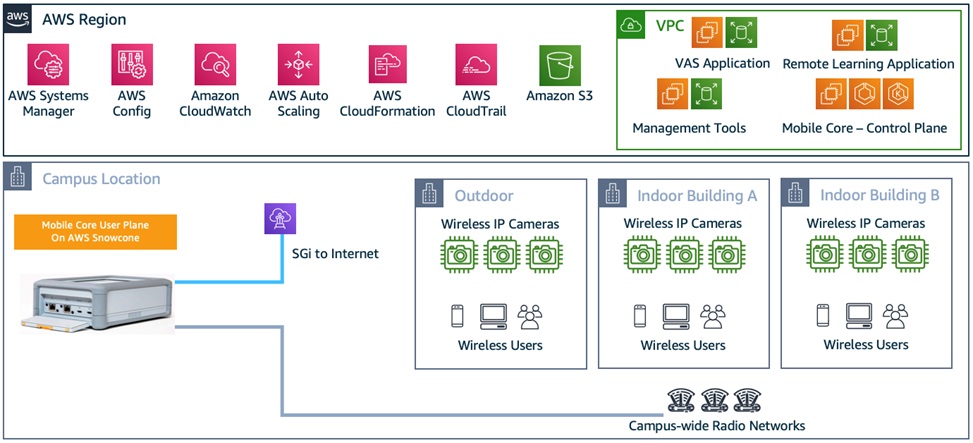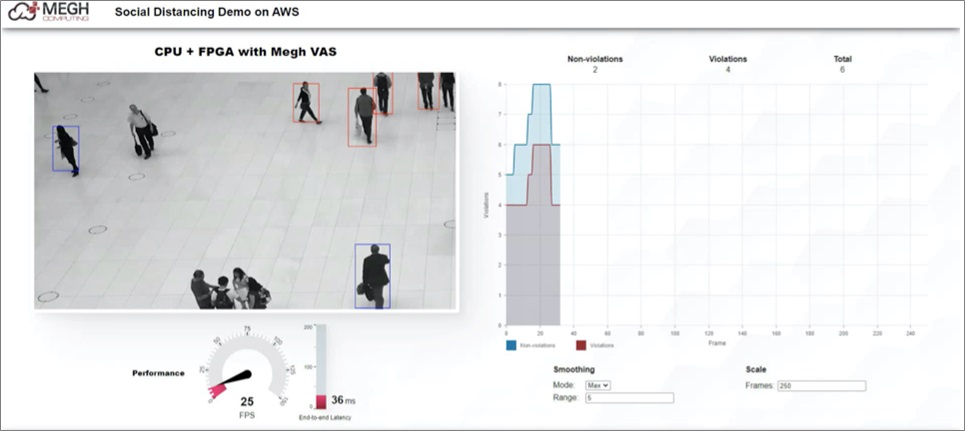AWS Partner Network (APN) Blog
Intelligent Video Analytics and Effective Remote Learning on Campus Private 4G/5G Networks
By Sigit Priyanggoro, Robin Harwani, and Mohan Baskaran – AWS
By Jim Blakley, Living Edge Lab Associate Director – Carnegie Mellon University
By Prasad Rampalli, Board Advisor CETF and Chief Business Officer – Megh Computing
By Prabhat Gupta, Co-Founder and CEO – Megh Computing
Enterprises demand secure wireless networks that can be trusted with mission-critical tasks. As digital transformation and Internet of Things (IoT) become business imperatives, 4G and 5G private networks are a must to connect everything from robots, cameras, signage, and machinery to virtual reality applications.
At the same time, the demand for real-time stream processing is increasing rapidly with the explosion of streaming data from IoT sensors, the web, and other sources. Enterprises want to extract business value by processing this data while in motion using real-time analytics at the edge.
Amazon Web Services (AWS) and its AWS Partner Network (APN) community enable modern enterprises to build their own private 4G or 5G private networks.
The depth and breadth of AWS services allows real-time video analytics solutions (VAS) to be deployed in combination with the private 4G or 5G networks, supporting various use cases including social distancing, people counting, and geo-fencing. AWS Snow Family, for example, provides edge infrastructure and software that moves data processing and analysis as close as necessary to where data is created in order to deliver intelligent, real-time responsiveness.
In this post, we’ll explore the use case for a physical distancing video analytics solution. This solution was developed together by Carnegie Mellon University’s Open Edge Computing Initiative, Megh Computing’s Video Analytics Solution, and Federated Wireless Private Network Connectivity as a Service.
Solution Overview
The figure below shows a high-level architecture of the solution which utilizes AWS Snowcone as edge computing infrastructure to deploy mobile core user plane function inside the campus location.
The in-campus mobile core user plane is the gateway for campus-wide radio networks utilizing Citizens Broadband Radio Service (CBRS) spectrum. Amazon EC2 F1 instances use Field Programmable Gate Arrays (FPGAs) to enable delivery of custom hardware accelerations including the VAS for the physical distancing application.
Figure 1 – Campus private 4G/5G networks with video analytics and remote learning.
Private 4G/5G Networks with AWS
Federated Wireless, an AWS Select Technology Partner, includes planning, design, build, operation, and support for a private 4G/5G wireless network, enabling enterprises to reap the benefits of private wireless with minimum risk and capital expenditure.
Private Wireless Connectivity-as-a-Service (CaaS) is available on AWS Marketplace, and includes the following network elements:
- Radio access using 4G/5G technologies.
- Core network services for control and packet processing.
- APN support to reach applications in the local network as well as the internet.
- End-to-end network management via a unified portal.
- Service delivery and fulfillment tracking through a single pane of glass.
- Spectrum sharing service to allocate and manage spectrum (CBRS).
- Seamless integration with an enterprise’s existing onboarding platform.
The Private Wireless CaaS solution includes options for stand-alone access points, as well as a centralized RAN where the signals from multiple antennas and remote radio heads are processed on a centralized server.
The capability to host on-premises hardware, and the virtualized RAN using industry standard architecture, gives Federated Wireless the complete flexibility to pick the right solution for our customers based on their deployment needs.
The Private Wireless CaaS core components provide cost-effective and IT-friendly connectivity to the public internet, subscription management (SIM handling), and connectivity policy management. Enterprise customers will be able to define and apply network policies that gives them complete control over their end user devices and IoT sensors.
The solution includes the industry-leading Spectrum Controller service on AWS that manages CBRS spectrum for the enterprise network. The Spectrum Access System (SAS) service may interact directly with each radio, or to a domain proxy that handles the SAS interaction for all the radios in the deployment.
An integrated network management portal on AWS helps in the configuration, monitoring, and management of the end-to-end service.
Customers will be able to track network health through KPIs as well as low-level diagnostic and troubleshooting information. The zero-touch configuration and onboarding of network components makes commissioning and upgrade/rollback activities a simple process.
The customer portal also provides complete visibility of the end-to-end fulfillment tracking for the customer’s network, all the way from procurement through deployment and commissioning.
Physical Distancing Video Analytics Solution on AWS
While the need for advanced real-time analytics continues to grow, it increasingly poses extreme, sometimes prohibitive, demands on compute infrastructure. Specifically, it often requires exceptionally low latency and high throughput and scalability.
First wave (CPU-based) and second wave (GPU-based) data center infrastructure face key constraints that limit their ability to support advanced real-time analytics of streaming data.
A third wave—using FPGA-based accelerators—delivers the required performance but poses challenges relating to hardware integration, device programming and management, and application integration. Several recent trends, however, address these barriers, enabling FPGA acceleration of real-time analytics for higher compute efficiencies and lower latencies.
Enterprises face a variety of challenges in implementing big data initiatives, including security, budget, integration with existing systems, and talent.
A typical streaming data analytics pipeline includes three stages:
- Ingest – Streaming data in different formats (structured, time series, video, audio, images, text, etc.) is processed to obtain and prepare a payload for further processing.
- Transform -Data is extracted, transformed, and loaded (ETL) for analysis.
- Infer – Today, this normally involves using machine learning (ML) or deep learning networks to discern patterns or recognize images.
Megh Computing provides a comprehensive vertical stack to abstract the complexity of FPGA programming and management, and support transparent application integration. The physical distancing VAS built on Amazon EC2 F1 instances utilizes FPGAs to enable delivery of custom hardware accelerations.
Figure 2 – Megh Computing physical distancing VAS built on Amazon EC2 F1 instances.
The Video Analytics Solution on AWS provides the following value proposition.
- High performance efficiency.
- Artificial intelligence (AI) acceleration with FPGAs delivers low total cost of ownership (TCO) compared to CPUs and GPUs.
- Low deterministic latency processing (< 100ms) to support real-time use cases at the edge.
- High prediction accuracy: ~90 percent of objects detected in a single frame with >50 percent confidence.
- Application flexibility.
- Extensible framework to implement single-stage or multi-stage models efficiently.
- Different deployment options for edge-to-cloud configurations.
- Scalability.
- Scale-up to scale-out configuration for small systems to large systems.
- Easily deployable deep learning models to support simple to complex use cases.
Carnegie Mellon University Use Case
As part of the exploratory use case research within CMU’s Open Edge Computing Initiative, there are three specific goal categories to achieve.
First is enabling effective long-distance remote learning tools and application services with private networks utilizing a “push-button” catalog service on Amazon Elastic Compute Cloud (Amazon EC2). The overall goal is to improve classroom experiences, project team collaboration, and access to student resources and applications.
Today’s use case goal is to provide reliable access and team collaboration using both audio and video channel. The next mid-term use case goal is to enable Augmented Reality/Virtual Reality (AR/VR) tools for immersive student experiences in remote environment.
Second, physical distancing guidelines which can be enabled and adjusted rapidly under various conditions. Some parameters to consider are the number of students in a classroom or lab, required minimum distance between persons, adherence to face mask policies, and contact tracing solution. Another consideration is zone restriction, which can only be accessed by site or facilities personnel.
Third was investigating adherence to security and privacy requirements. For example, no face recognition except by trusted authorized users in specific cases. For example, only the university health officer can identify people who have come in contact with a known COVID-19 positive student, staff or faculty on campus. We also require protected storage of faces and personally identifiable information (PII) compliance to prevent unauthorized surveillance.
Conclusion
Edge computing is a new paradigm in which the resources of a small data center are placed at the edge of the internet, in close proximity to mobile devices, sensors, and end users.
High-performance edge applications rely on the cloud for processing, analytics, storage, and machine learning, but also need to do some processing, like ML inference, close to where data is generated to deliver intelligent real-time responsiveness, and reduce the amount of data transferred.
The Physical Distancing Video Analytics Solution (VAS) on campus private 4G/5G networks discussed in this post is an exploratory use case research. This solution was developed utilizing AWS edge services in partnership with Carnegie Mellon University’s Open Edge Computing Initiative, Megh Computing’s Video Analytics Solution, and Federated Wireless Private Network Connectivity as a Service.
AWS edge computing services provide infrastructure and software that move data processing and analysis as close to the end-point as necessary. This includes deploying AWS managed hardware and software to locations outside AWS data centers, and even onto customer-owned devices themselves, which open different possibilities to solve business challenges.
If you need to run your edge applications with single-digit millisecond latencies to mobile devices and end-users, you can choose AWS Local Zones or AWS Wavelength. If you would like to run your applications on-premises, you can choose AWS Snow Family and/or AWS Outposts.
Learn more about AWS for the edge and these initiatives on edge computing, FPGA application development, and private wireless networks:

